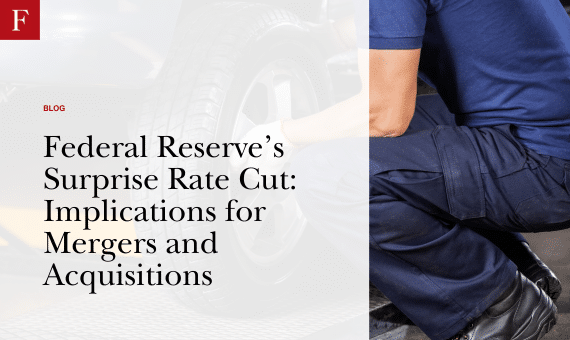
Federal Reserve’s Surprise Rate Cut: Implications for Mergers and Acquisitions
In a move that caught everyone by surprise, the Federal Reserve implemented a 0.50% interest rate cut, doubling the anticipated 0.25% reduction. This more aggressive monetary policy shift reflects the central bank’s heightened concerns about economic stability and its commitment to stimulating growth. But what does this mean for the M&A landscape?
Why the Rate Cut Matters
The Federal Reserve’s interest rate decisions directly influence borrowing costs, investment activity, and the overall economy. A rate cut reduces the cost of borrowing, making credit cheaper for consumers and businesses. In turn, this typically stimulates investment and spending, helping to buoy economic growth during periods of uncertainty or slower expansion.
For buyers, who rely heavily on debt financing to fund acquisitions, a rate cut—especially one larger than expected—creates immediate opportunities. Here’s how:
Private equity firms typically use leverage (borrowed capital) to finance a significant portion of their acquisitions. A reduction in interest rates directly lowers the cost of this debt; borrowing becomes even more attractive, reducing the interest burden on leveraged deals.
This increased affordability can boost the returns for investors, making acquisitions more appealing.
Historically, periods of lower interest rates have been associated with a surge in M&A activity. With the unexpected cut, many firms may see an opportune time to accelerate deal-making efforts. Lower financing costs can encourage more aggressive acquisition strategies, potentially increasing deal volume.
Moreover, as businesses anticipate further economic stimulus from the Fed’s actions, there may be an uptick in companies willing to explore selling or merging, adding to the pipeline of opportunities.
While lower interest rates may fuel M&A activity by making financing cheaper, they also influence company valuations. In a low interest environment like years prior, buyers found themselves facing inflated valuations due to the inexpensive cost of debt. The reduction in borrowing costs could lead to more competitive bidding for attractive targets in the M&A space, as firms are able to offer higher valuations supported by cheaper debt.
Its important to note that rates are still high compared to the record lows in 2020-2022 that spurred record high M&A activity and valuations. Some buyers were burned paying very high multiples in the near-zero interest rate environment; you can be certain that much more caution will be used this time around.
Rate cuts can also influence the timing and strategy for private equity exits. The aggressive cut may make selling portfolio companies more appealing, as buyers may be willing to pay higher multiples given their own reduced financing costs. The next few months will be important to watch. If the Fed continues to cut rates, you can expect to see more activity from the groups that have held on to their investments for several years.
While the aggressive cut was a welcome surprise, it also raises questions about the broader economic outlook. The fact that the Fed felt implemented a larger-than-expected cut may signal concerns about economic growth, specifically with regards to unemployment, which is trending in the wrong direction.
While I expect to see some increased activity, my gut feel is it will be a slower approach compared to the previous rush in 2020.
This article was previously publish on Tire Business.














